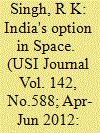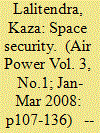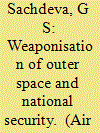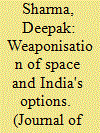| Srl | Item |
| 1 |
ID:
120416


|
|
|
|
|
| Publication |
2013.
|
| Summary/Abstract |
India's relationship with the nuclear non-proliferation regime deteriorated sharply after its 1974 underground nuclear test which, according to India, was a peaceful nuclear explosion, but which was not accepted as such by the regime. That it did not follow up with immediate weaponisation challenged the core logic of the non-proliferation regime which operates on a Murphy's Law of 'nuclear fatalism', i.e. if a country has the know-how to produce nuclear weapons, it will certainly produce them. This article argues that at least until the beginning of its integrated guided missile development programme in 1983, India's nuclear inaction posed a normative challenge to this logic.
|
|
|
|
|
|
|
|
|
|
|
|
|
|
|
|
| 2 |
ID:
117213


|
|
|
| 3 |
ID:
080650


|
|
|
| 4 |
ID:
111289


|
|
|
|
|
| Publication |
2012.
|
| Summary/Abstract |
The latest report of the International Atomic Energy Agency (IAEA) on Iran's alleged nuclear weapons programme, released on November 8, 2011, has effectively raised the global threat level. The agency faced the daunting challenge of making a judgement on how far Iran's nuclear programme has advanced and its potential for weaponisation on the basis of suggestive but dated, inconclusive and possibly fake evidence (hundreds of pages of evidence have been sourced to one laptop of unproven provenance given to the IAEA by a Western intelligence agency).
|
|
|
|
|
|
|
|
|
|
|
|
|
|
|
|
| 5 |
ID:
084181


|
|
|
| 6 |
ID:
098320


|
|
|
|
|
| Publication |
2010.
|
| Summary/Abstract |
During Cold War era, space became an essential adjunct for war-fighting on
the ground, without becoming another theatre of combat. While militarization
of space proceeded rapidly, the weaponisation of space was avoided. Because
the weaponisation of space was avoided during the Cold War, it does not
necessarily follow that weaponisation will continue to be avoided in a new era
of asymmetric warfare. We can improve protection of satellites against some
threats, but satellites will remain easy targets for space weapons designed to
kill on impact. Space has been free from warfare. No weapons have ever been
used in or from space, and no satellites have been destroyed in combat. A
glance at the global strategic situation reveals that many nations are rushing
to develop space capability. The capabilities in development around the world
are largely dual use and will have profound effects on the balance of power.
The issue at hand is how to effectively manage the security dilemmas that
will inevitably arise due to weaponisation of space. Many space faring nations
think that future wars will/may be fought in all medium including space. The
laws of aerodynamics cease to apply in space and one is therefore obliged to
consider it as a medium different from air. It is still far easier and more likely
for surprise attacks to be carried out on the ground than in space. During the
Cold War, nuclear-tipped missiles were always ready to fire. We will be safer if
we can prevent elevating this hair-trigger situation into space. If India has to
look at the threat to its space assets, it can be concluded that though there is
a threat to space assets from our perceived adversary, it is neither critical nor
alarming. Indian defence forces primary dependence on space based systems
if any, can easily be transformed to secondly by developing alternates for both
ground and aerial platforms. In future the dependence on space based systems
can be further reduced by India by inducting state-of-the-art alternate systems
to supplement the space system as alternates.
|
|
|
|
|
|
|
|
|
|
|
|
|
|
|
|